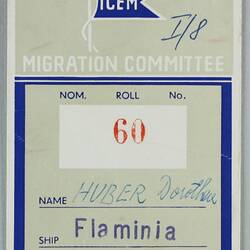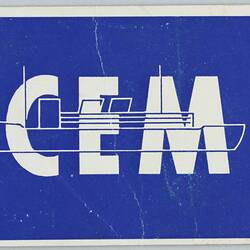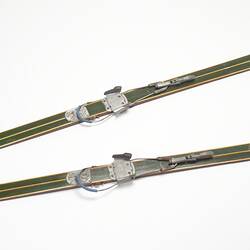Summary
Baggage label issued to Dorothea Huber [nee Freitag and later Dunzinger] in preparation for her migrant voyage from Austria to Melbourne onboard the 'M/N Flaminia' in 1959. The ship departed from Genova, Italy and sailed via Port Said, the Suez Canal, Aden and Fremantle. The baggage label was issued by the Intergovernmental Committee for European Migration (ICEM) which was established in Geneva in 1951 to help resettle people displaced after World War II. As a member, Australia made arrangements to accept assisted migrants with a number of European countries including Austria, Belgium, Greece and Spain.
Born in 1929 near Graz, Austria, Dorothea Dunzinger [formerly Huber and nee Freitag] was a proficient recreational skier and part of a volunteer rescue team in Switzerland. She lived and worked primarily as a mill weaver and seamstress in England, Switzerland and Austria before migrating to Australia from Austria on 30 November 1959, arriving on the Cogedar Line ship 'Flaminia' on 31 December. She settled in Melbourne and married fellow Austrian Johann Dunzinger whom she met at Broadmeadows migrant hostel. They had a daughter Caroline and lived in various Melbourne suburbs boarding and renting before building a home in Kalorama. The couple divorced in1978. Dorothea worked hard all her life, owning a boutique clothing shop in Camberwell at one stage but primarily as a textile outworker and factory worker trying to make ends meet. She died in 2001.
Physical Description
White card label printed on one side with 'ICEM' logo on blue background and reverse side printed on grey background with passenger name and ship details. There is a metal punch hole at one end.
Significance
The Dunzinger Austrian Migrant Collection has evolved to become a rich group of objects which tell a particular story of an Austrian woman's post-war migration experiences, as well as broader contextual narratives relating to the variety of selection and management processes in place in Europe after World War II. These include references to Australian-specific organisations involved in migration management such as the Australian Migration Mission. Items explore the enthusiastic promotional activities of the Australian Government to encourage migration from the UK and Europe in order to populate Australia and build a workforce. Artefacts also relate to a significant Italian migrant ship of the period, the Cogedar Line 'Flotto Lauro'.
There is a also symbolic poignancy about the skis and the small sewing machine Dorothea Dunzinger brought with her from Austria: the skis representing precious mementoes from home and hopes and expectations for the leisure activity they might bring in Australia; the sewing machine a pragmatic object which came to dominate Dorothea's actual settled life of hard work both in the home and as an outworker with no leisure time at all.
More Information
-
Collecting Areas
-
Acquisition Information
Donation from Ms Caroline Dunzinger, 07 Nov 2012
-
Past Owner & User
-
Ship Named
MN Flaminia (Motor Vessel), Cogedar Line, Genoa, Italy, 1959
-
Organisation Named
-
Inscriptions
Front side: 'ICEM' Reverse side: 'MIGRATION COMMITTEE/ 60/ NAME [handwritten]Huber Dorothea/ SHIP [stamped]Flaminia Australia'
-
Classification
Migration, Processing - planning & departure, Luggage handling
-
Category
-
Discipline
-
Type of item
-
Overall Dimensions
75 mm (Width), 135 mm (Height)
-
Keywords
Austrian Immigration, Shipboard Travel, Ships, Luggage, Immigration Selection, Immigrant Voyages, Immigrant Shipping, Immigration, Migration Schemes



